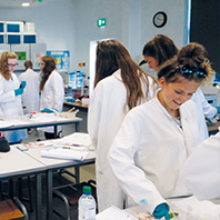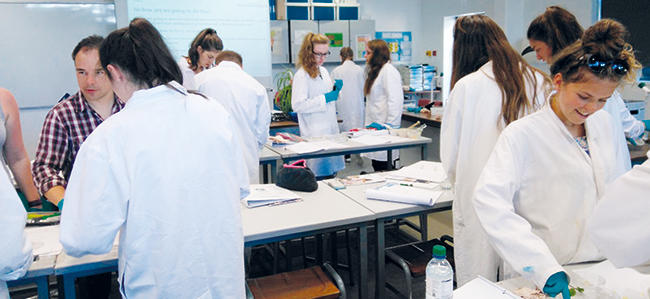Outreach: Education and Outreach and the microbiome
09 May 2017

Antimicrobial resistance and the microbiome
Dr David Cleary’s research and work focuses on antimicrobial resistance and the microbiome. Using a grant, David and colleagues are continuing their outreach work from last year by delivering activities based around microbiology and infectious disease to Jersey-based A-Level students attending a Biomedical Sciences Summer School.
As a Research Fellow working in microbial genomics, David’s research concerns how bacteria in the airways cause acute respiratory infections or exacerbations in chronic conditions such as COPD or asthma. This involves examining the dynamics of the microbiomes of the upper respiratory tract, the focus being on how the microbiome and, in particular, the epidemiology of Streptococcus pneumoniae, Haemophilus influenzae and Moraxella catarrhalis change in response to the introduction of new vaccines.
In 2016, David, along with Dr Michael Head and Dr Rebecca Brown, went to Jersey College for Girls to run an outreach activity. Three areas of microbiology research stood out as being particularly topical: antimicrobial resistance (AMR), microbiomes, and the continued need for vaccines and vaccine-related research. The group decided to give three talks throughout the day to introduce the topics and highlight the importance of each in the context of infectious disease research.
The talks were designed to pique the students’ interests and underpin the learning of what, to the group, was the most important element: getting students into the laboratory to give them hands-on experience of microbiology-related activities. Throughout the day, the group ran a laboratory session that focused on concepts that were highlighted in the AMR talk. The practical itself was straightforward: the group gave the students a choice of common household cleaning products (disinfectants, hand gels) as well as more natural products such as onion, garlic and various spices. The students then had to apply their expectations as to what would be the most effective antimicrobial against Escherichia coli.
The outreach award from the Microbiology Society will help the team improve the practical session. They plan to combine the general overview topics from the first event with a practical drawn from the current research that will introduce the students to the use of genomics to identify AMR genes in bacterial pathogens. The general methodologies that they are adopting will also provide the opportunity to characterise the microbiome of the student’s nasopharynx (the bit at the back of the nose). Their approach will be to give students hands-on experience using some of the latest DNA sequencing technologies to generate their own data, either on common bacterial species resident in the respiratory tract or from their own microbiome. The team aim to then publish their output – and hope that the students seeing their microflora ‘in lights’ will inspire them to continue a career in research.
Dr David Cleary

Good Germs, Bad Germs
Dr Jamie Lorimer and colleagues from the University of Oxford are running a project called ‘Good Germs, Bad Germs’ to engage the public with the growing field of microbiome research, and investigate people’s attitudes towards cleanliness.
The project is led by social scientists and looks at hygiene – how people think about and practise it. Investigations are centred on the domestic kitchen microbiome and participants were asked to swab various areas of their household kitchen before and after some kind of hygiene intervention. The difference with this project compared to other citizen science projects is that the participants were involved in the formation of the research questions, known as a ‘participatory approach’ to science.
The group has run a series of focus groups in Oxford with 14 households who meet every few months to design the next experiments, and for the team to assess the participants’ perceptions of microbes. These perceptions include what they think microbes are, where they come from, and what constitutes a ‘clean’ kitchen.
Several experiments have been carried out so far. In one experiment the effectiveness of various cleaning products, and what happened to the microbiome of surfaces before and after products were used, has been investigated. The results of this experiment showed that the product used made little difference to the types of bacteria present on the surface, but it was the cloth that was most important in re-seeding the surface after it was cleaned. Other experiments include: each household swabbing the same five surfaces in their kitchen and an additional surface of their choosing; using a brand new chopping board and recording what it had been used for while swabbing at various intervals over a two-week period; swabbing participants’ fridges to look at the make-up of the microbiome, and the effect temperature has on the microbiome. In addition to these experiments, participants were allowed to decide on their own experiments individually. Most households chose to incorporate their pet’s microbiomes in some way and to look at where their pet’s microbiome signature shows up in their kitchen.
It is hoped that the results of this project will reveal how households’ attitudes towards hygiene have changed during the study. By introducing microbes and the concept of the microbiome to people, this will help to inform people about what good hygiene is and debunk the idea that all micro-organisms are bad.
Dr Jamie Lorimer
To find out about Education and Outreach activities, visit our website.
Hannah Forrest
Public Engagement Officer
[email protected]
Image: Participants in the Summer School at Jersey College for Girls. Dr Michael Head.


